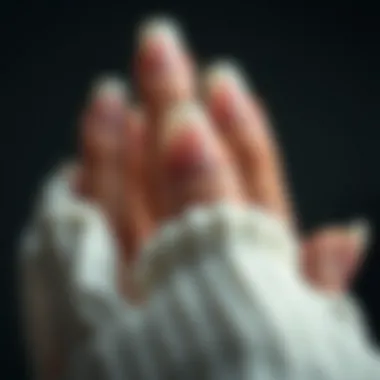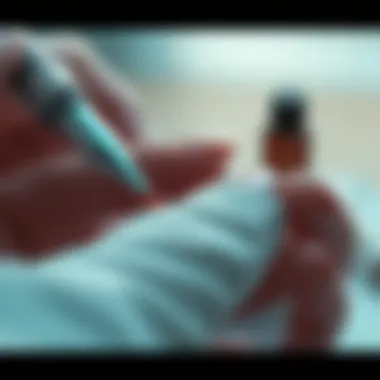A Comprehensive Guide to Nail Clips for Gel Removal


Intro
With the rising popularity of gel nail polish, removing it safely and effectively has become a crucial skill for both nail enthusiasts and professionals. The introduction of nail clips designed for gel removal has made this task easier. Nail clips not only help in softening the gel but also aid in reducing damage to the natural nail underneath.
This guide meticulously explores different types of nail clips, their application techniques, and the strengths and weaknesses you could face while using them. Moreover, understanding the technical details and nuances involved in the nail removal process will arm you with the proper strategies needed for effective gel nail care.
Current Nail Trends
In the world of manicures, staying on top of trends can be just as vital as the nails themselves. Nail clips have evolved alongside nail art, adapting to the ever-changing landscape of nail fashion.
- Innovative Designs: Nail clips have grown beyond basic functionality, incorporating artistic designs that can complement seasonal nail trends. This combination of style and usefulness is gaining traction in salons around the world.
- Sustainability Considerations: As sustainability takes center stage, some brands are now offering eco-friendly nail clips made from recycled materials. This shift not only contributes to a healthier environment but also attracts eco-conscious clients.
Types of Nail Clips
Understanding the different types of nail clips available in the market can significantly impact the removal process.
- Standard Clips: These are the classic choice and come in various sizes, allowing you to choose the best fit for your nails. They generally have a straightforward design, making them user-friendly for many.
- Foil Wrap Clips: A more advanced option, foil wraps are designed to hold a cotton pad soaked in acetone against the nail. These provide a stronger, more even pressure, leading to quicker gel breakdown.
- Weighted Clips: For those who prefer a more substantial grip, weighted clips can offer enhanced stability. Their additional weight helps them stay put, allowing for hands-free operation during the removal process.
Application Tips for Effective Use
When it comes to removing gel nails, proper technique can save you time and protect your nails. Here are some pointers to keep in mind:
- Preparation is Key: Before applying nail clips, ensure to file the gel top layer to allow the acetone to penetrate better.
- Use High-Quality Acetone: Not all acetones are created equal, so using high-quality products can expedite the removal process.
- Monitor the Time: Keep an eye on the recommended time for soaking, typically around 10 to 15 minutes, to avoid overexposure of your natural nails to acetone.
By understanding and optimizing your technique, you not only achieve a seamless gel removal but also take significant strides towards maintaining the health of your natural nails.
Benefits and Drawbacks of Nail Clips
Just like any other tool, nail clips come with their share of pros and cons.
- Benefits:
- Drawbacks:
- Reduces direct contact with acetone, limiting skin irritation.
- Provides a more uniform pressure while holding the cotton pad.
- Enhances the effectiveness of the removal process.
- Some users find them uncomfortable if not fitted properly.
- Can be a bit clumsy for DIY users due to their rigid form.
Understanding the balance between these benefits and drawbacks can help ensure that you choose the right tools for your nail care regimen.
Understanding Gel Nails
The section on understanding gel nails lays the groundwork for both nail care enthusiasts and professionals alike. Gel nails have gained significant traction in the beauty industry, appealing to those who seek durability and a polished finish. However, diving into this topic goes beyond mere aesthetics; it reveals the complexities of application, maintenance, and removal. Knowing the ins and outs of gel nails can help make informed decisions and assure a better outcome in terms of longevity and nail health.
What Are Gel Nails?
Gel nails are essentially a type of artificial nail enhancement created from a mixture of polymers that harden under ultraviolet (UV) or LED light. Unlike traditional polish, gel nails offer a glossy finish and are less prone to chipping and fading. But beyond that, they come in two primary types: hard gels and soft gels. Hard gels are usually used for extensions, while soft gels provide a more flexible feel, making them easier to remove. This distinction is vital when considering a specific service in a salon setting or even for personal use at home.
The Application Process
Applying gel nails is a meticulous process that requires several steps to ensure a flawless finish. First, the nails must be properly prepared, which involves cleaning the nail bed, buffing, and applying a primer. This often sets the stage for stronger adhesion of the gel. Following that, the nail technician or the individual applying the gel usually layers the gel product on top of the nails, curing it under a UV or LED lamp for a specific duration.
It's crucial to note that the curing times can vary based on the gel type and lamp strength. Once all layers are applied and cured, a top coat is usually added, which is then cured again to yield a durable, shiny finish. This entire process, when executed correctly, can last anywhere from two to three weeks before looking tired or in need of a refresh.
Popularity and Usage
The popularity of gel nails can’t be overstated. With their appeal stretching across various demographics, they have become a staple in nail salons around the world. Many users are drawn to their versatility; they can be fashioned in countless designs, from simple manicures to intricate nail art. Moreover, gel nails have proven beneficial for individuals with busy schedules. Their extended wear time means fewer trips to the salon, making them a practical choice for those balancing work and personal life.
However, it’s essential to acknowledge that not all gel nail products are created equal. Some lower-quality options might not adhere as well, leading to issues like lifting or premature wear. Thus, recognizing reliable brands and products is advisable, as this knowledge could save both time and money in the long run.
"Gel nails provide a flashy and resilient alternative to conventional nail polish, quickly becoming synonymous with modern nail care."
Understanding gel nails is the first step towards mastering their application and removal, making it a crucial topic for anyone involved in nail care.


The Importance of Safe Gel Removal
Gel nails have gained traction for their long-lasting finish and glossy appearance. However, their removal is just as crucial as the application, requiring careful attention to ensure the integrity of the natural nails. Safe gel removal is not merely a cosmetic choice; it's a significant aspect of overall nail health that can prevent potential dangers associated with careless practices. In this regard, understanding the importance of safe gel removal can significantly influence one’s nail care routine.
When gel nails are removed improperly, the consequences can be dire. The first red flag often observed post-removal might include weakened or damaged nails. Over time, aggressive or careless removal techniques can lead to significant problems, such as nail thinning or even bacterial infections. Therefore, maintaining a level of diligence and care during this process is essential.
Risks of Improper Removal
Improper gel nail removal techniques pose various risks and should never be glossed over. One major concern is the potential for nail bed damage. Utilizing excessive force to peel away gel polish can result in the tearing of layers from the natural nail, exposing sensitive tissues underneath. Furthermore, treatments that involve harsh chemicals, like acetone, can lead to dehydration of the nail and surrounding skin, contributing to both brittleness and irritation. Here’s a closer look at these risks:
- Nail Bed Trauma: Peeling or scraping at the gel can result in deep grooves or imperfections in the nail bed. This damage can be both painful and take a long time to heal.
- Infections: Moisture retained beneath the gel polish after an improper removal can create a breeding ground for bacteria, leading to infections that could necessitate medical attention.
- Long-Term Weakness: Frequent misuse of gel removal can lead to chronic nail weakness, making them more prone to breakage in the future.
"Taking the time to remove gel nails safely is an investment in the health of your natural nails. It’s worth every moment spent doing it right."
Maintaining Nail Health
Taking care of natural nails must come first, and safe gel removal plays a pivotal role in that. Here’s how properly handling the removal process contributes to making nails healthy:
- Hydration and Restoration: After the gel removal process, nails often require hydration. Products that contain nourishing oils or creams can restore moisture to the nails and surrounding skin, helping to fortify them.
- Gentle Care Practices: Using the right tools, such as nail clips designed for gel removal, minimizes unnecessary stress on the nails. This gentle approach encourages healthy nail regeneration.
- Regular Breaks: Allowing the nails to breathe by taking breaks from gel applications can prevent overexposure to potentially harmful elements, such as powerful adhesives and chemical removers.
- Consult a Professional: While DIY might be tempting, sometimes a professional touch is needed. An experienced nail technician can provide expert advice tailored to individual nail types, ensuring the least amount of damage occurs.
An Overview of Nail Clips
When it comes to the nuanced art of gel nail care, nail clips play a pivotal role. These small yet mighty tools can make the difference between a smooth gel removal and a frustrating experience fraught with the potential for damage to your natural nails. Understanding how different types of nail clips function, along with selecting the best one for your needs, can significantly enhance your gel nail removal experience.
Types of Nail Clips
Knowing the various types of nail clips available can be likened to understanding different tools in a professional toolbox. Each type has unique characteristics and specific uses tailored to various preferences.
Standard Nail Clips
Standard nail clips are perhaps the most commonly recognized types of clips in the nail salon realm. Their simplicity and effectiveness make them a go-to for many.
"Standard nail clips are easy to use, providing a firm grip that helps hold the cotton pad soaked in remover in place, ensuring an even application."
One key characteristic is their traditional design, typically made from plastic or metal, allowing for strong clamping on the nail tips. This ability is particularly significant when doing a thorough soak-off of gel as it minimizes the chances of the remover evaporating too quickly. A potential disadvantage, however, is their lack of heating capability through which some may find faster results with heated alternatives.
Heated Nail Clips
Next come the heated nail clips, distinguished by their ability to apply a gentle warmth to the nails during the removal process. The warmth aids in softening gel further, often speeding up the removal time. Many users find these clips beneficial because the added heat increases the effectiveness of the remover. However, care must be taken not to overheat, as this could lead to discomfort or even slight burns on the skin surrounding the nails. Thus, while heated clips can enhance the gel removal experience, they require careful attention to prevent mishaps.
Multi-Purpose Clips
Multi-purpose clips have emerged as a versatile option for those who prefer flexibility. As the name implies, these clips are designed for more than just nail removal; they can often be used for other nail enhancements as well, allowing stylists and end-user alike to maximize their tool investment. Their adaptability is a significant plus in today's busy salons, where time is money. Key feature is their design, which can usually accommodate various sized nails. However, some may find that the constant switching between functions might lessen their effectiveness in each individual task compared to specialized clips.
Choosing the Right Clip
Selecting the right nail clip is a bit like finding the right pair of shoes; comfort and fit matter greatly. Factors to consider include your specific needs, the type of gel product you use, and your overall removal process. Choosing wisely can result in both optimized results and the health of your natural nails. For stylists, understanding client preferences, the typical duration of gel wear, and potential nail health issues will inform the decision on which clip to use, ensuring that every gel nail service culminates in satisfaction.
The Gel Removal Process Using Nail Clips
Using nail clips for gel removal is not just a trend; it is a pivotal step that can enhance the overall nail care routine. This section outlines the multifaceted process involved in using these tools effectively. By carefully following a structured process, users can ensure a thorough and safe removal of gel nails, minimizing potential damage to the natural nail.
Preparing the Nails
Before diving into the actual removal, preparation is key. The initial step is to ensure that the nails are clean and dry. Any residual polish or oil can hinder the effectiveness of the clips. A gentle nail file can be employed to gently buff the surface of the gel nails. This light buffing exposes the gel topcoat and allows the acetone to penetrate more effectively.
Here are some essential steps to prepare the nails:
- Wash your hands thoroughly to remove any dirt and bacteria.
- Buff the topcoat of the gel nails lightly.
- Choose the right clips suitable for your nail size and thickness.
- Have your acetone solution ready for use.
Ultimately, these preparatory steps lay the groundwork for a successful gel removal experience, reducing the chance of mishaps or nail damage.
Proper Application Techniques
Once the nails are ready, the application of nail clips comes into play. These clips are designed to hold cotton or pads soaked in acetone against the gel, allowing it to dissolve effectively. Achieving the right application is vital for efficient removal. Here's how to do it:


- Soak cotton balls in acetone—have enough for every nail.
- Place the acetone-soaked cotton directly on top of the gel nail.
- Secure the cotton with the nail clip, ensuring firm pressure but not too tight to cause discomfort.
It is crucial to position the clips correctly. They should be tight enough to hold the cotton in contact with the gel but loose enough to avoid pinching the nail or skin. If the clips are too tight, it can lead to unnecessary irritation, while too loose might disengage the cotton from the gel.
Timing and Patience
Patience is paramount when utilizing nail clips for gel removal. It's tempting to rush the process, but remember that good things take time. On average, leaving the clips on for about 15 to 20 minutes should suffice for most gel types.
During this waiting period, keep an eye on the nails. Checking occasionally will allow you to observe how well the gel is lifting. Once you notice the gel beginning to bubble and separate from the natural nail, you're on the right track. Here are some tips:
- Set a timer to prevent over-soaking.
- Use this time to relax or multitask, but do not forget to check in!
- If the gel has not lifted after the initial time, you can re-soak the cotton and clips for an additional 5 to 10 minutes.
Ultimately, exercising patience during the removal phase leads to a smooth process, safeguarding your natural nails from damage.
Common Mistakes to Avoid
Removing gel nails using nail clips can be a straightforward process, but it’s not without its pitfalls. Often, it’s the unwitting errors that create havoc, resulting in damaged nails or inefficient removal. Understanding these common blunders is critical for anyone looking to maintain nail health post-gel application. Not only do these mistakes impede effective removal, but they also place unnecessary strain on your natural nails. Addressing these errors can enhance your nail care routine and ensure that your nails remain strong and healthy.
Overusing Nail Clips
The temptation to use nail clips continuously throughout the removal process is undeniable. After all, why not speed things up when dealing with stubborn gel? However, overusing nail clips can lead to disastrous results. Excessive use can create pressure on the nail bed, making it more susceptible to damage. It could even lead to issues like nail thinning or delamination.
Ingredients in gel formulations can vary widely, affecting how they respond to removal. If pitted with sticky remnants, it can be tempting to keep clips in place longer, but this does more harm than good. It’s advisable to monitor the progress of gel dissolution rather than relying on clips alone.
Keep in mind that:
- Prolonged pressure from clips can misalign nail growth.
- Consider alternating between clips and gentle scraping for better results.
- Always remember that patience pays off—impatience can lead to careless mistakes and potential nail damage.
“If you haven't got time to do it right, when will you have time to do it over?” — John Wooden
Skipping Preparation Steps
Many people rush into gel removal, thinking that the clips are a stand-alone solution. However, skipping essential preparation steps, like soaking the nails in acetone or buffering the gel edges, can lead to a less effective removal process. This oversight can result in the clippings becoming glued to gel particles, making them more challenging to remove and causing unintended damage.
Preparation is key. It allows the gel to loosen significantly before applying nail clips, which is essential for a smoother removal.
Consider the following steps before you begin:
- Safety First: Always wear gloves to protect your skin from harsh solvents.
- Soak in Acetone: Allow your nails to soak for a minimum of 10 minutes. This provides enough time for the gel to loosen.
- File the Surface: Lightly buff the surface of the gel with a fine-grit file. This enhances the acetone's penetration.
Ultimately, spending a few extra minutes on preparation can save time and headache later on. By treating your nails with the care they deserve, you set the stage for a safer and more effective gel removal process.
Alternatives to Nail Clips
When it comes to removing gel nails, nail clips are often the go-to device for many, but they aren't the only option on the block. Understanding alternative methods is crucial, not only to cater to different preferences but also to enhance nail care routines without compromising nail health. Each method has its pros and cons, and it’s vital to consider them thoroughly.
Soaking Techniques
Soaking techniques present one of the most traditional alternatives to nail clips and may be favorable for several reasons. This method typically involves soaking the fingers in a solution specifically designed to break down gel polish. Using acetone is common, yet alternatives like non-acetone removers can be considered to reduce drying effects on the nails.
Benefits of Soaking:
- Gentleness: Soaking is often a softer approach, ideal for those who may have sensitive nails.
- Cost-effective: Generally, you won't have to buy special equipment beyond the remover itself.
- Thoroughness: Soaking can help in loosening the gel from the entire nail surface, ensuring a more complete removal.
Considerations:
- Soaking times can vary. It’s important to pay attention to how long you leave your fingers submerged to avoid any unnecessary nail damage.
- Ensuring the correct soak solution is integral. Always opt for high-quality removers to avoid skin irritation.
Professional Services
For those who might feel overwhelmed by the idea of nail removal at home, or perhaps they lack the patience required for soaking, professional nail services offer a reliable alternative. Visiting a salon ensures not only a proficient removal but often a pampering experience that can be quite relaxing, too.
Advantages of Professional Services:


- Expertise: Licensed nail technicians know the ins and outs of gel removal, utilizing best practices that minimize any possible damage to your natural nails.
- Personalized Care: Every individual’s nails are different. Professionals can assess your specific needs and offer tailored solutions, whether that means soaking, filing, or utilizing other methods.
- Comprehensive Treatment: Connecting the dots, many salons don’t just remove gel. They often provide aftercare treatments that can rejuvenate your nails post-removal, which is a significant bonus.
However, think about the cost and time involved; appointments can vary widely based on location and the services requested. So while salon visits are a great choice, they may not suit everyone's budget or schedule.
It’s essential to weigh your options and determine which method best aligns with your needs. Whether you go for the soak method or enlist the help of professionals, being informed is the first step towards ensuring the health of your nails after gel removal.
Post-Removal Nail Care
Taking proper care of your nails after gel removal is as critical as the removal process itself. Many individuals overlook this step, assuming their nails are fine since the gel has been taken off. However, the reality is that gel application and removal can be taxing on your natural nails. It's vital to give your nails the attention they need to recover and remain healthy.
After a round of gel nails, nails can be left brittle or thin, and sometimes even irregular. Therefore, post-removal care is essential to ensure the longevity and sturdiness of your nails. Here, we’ll dive into moisturizing and repairing practices, as well as preventive measures for future applications, which will help maintain the health and aesthetic of your nails.
Moisturizing and Repairing
Once the gel is off, your first line of defense in post-removal care is hydration. Natural nails need moisture to regain strength, elasticity, and a healthy appearance. Consider applying a high-quality cuticle oil to nourish the skin around your nails. Ingredients like jojoba oil or vitamin E can significantly help in promoting nail repair and health.
Benefits of Moisturizing:
- Restores Moisture: Gel removal can strip the natural oils from your nails, leading to dryness. Intensive moisturizers can restore hydration.
- Strengthens Nails: Regularly applying oil or cream can prevent nails from becoming brittle. Strengthened nails are less prone to breaking or chipping.
- Improves Appearance: Healthy, moisturized nails look more vibrant and appealing.
Here are a few actions you can consider:
- Massage cuticle oil daily to help nourish the nail bed.
- Use a moisturizing hand cream frequently to keep hands and nails hydrated.
- Consider a biotin supplement, as it is renowned for assisting with nail growth.
Remember that giving your nails some downtime is equally as vital. Avoid reapplication of gel nails immediately after removal; it's crucial to allow them some recovery time.
Preventive Measures for Future Applications
Once you've taken the necessary steps to repair your nails, it's time to think ahead. To keep your nails healthy in the long run, preventive measures are paramount. By adapting a few habits, you can significantly improve the resilience of your nails for future gel applications.
- Limit Gel Use: Allow for breaks between gel applications, ideally giving your nails a month or so to revive and regenerate.
- Choose Quality Products: Ensure any products you are using for your nails are high-quality. From the base coat to the top coat, the right products can make a world of difference.
- Hydrate Before Application: Treat your nails with a nourishing treatment before putting on gel. This will provide an extra layer of protection.
"An ounce of prevention is worth a pound of cure."
Frequently Asked Questions
In any comprehensive guide, the section on frequently asked questions holds substantial relevance. This segment not only addresses the common concerns and queries that may arise regarding nail clips and their use in gel removal, but it also serves as a vital resource for readers looking to make informed decisions. The questions posed often reflect real-world experiences and perspectives, making this part of the article more relatable and practical.
The importance of this section lies in its ability to provide clarity. It can demystify the misconceptions surrounding nail clips and gel nail removal, proving beneficial for those who are new to the process or for seasoned individuals facing specific challenges. Furthermore, a well-structured FAQ section promotes engagement, as it invites readers to ponder their own needs, ensuring they can navigate through nail care with confidence. Here, we tackle two pivotal questions to enhance understanding and support best practices.
Do Nail Clips Damage Natural Nails?
This question is prevalent, especially among those who appreciate and care about their natural nails. The concern that nail clips might cause harm arises from a misunderstanding of their actual function. When used correctly, nail clips generally do not damage the natural nails. The clips are designed to hold cotton soaked in acetone or a specialized solution against the gel, allowing the chemical to penetrate and dissolve the gel nail effectively.
However, improper use can lead to potential issues, such as:
- Excessive pressure: Applying too much force when fastening the clip can result in discomfort or localized trauma.
- Prolonged exposure: Keeping clips on longer than necessary can lead to nail dehydration or brittleness over time.
- Incorrect application: If the clips are not positioned properly or the nail is not sufficiently prepped, it might lead to uneven removal, causing stress on the natural nail.
To mitigate the risks, it is recommended to snugly but gently secure the clips and follow the guidelines pertaining to timing.
How Long Should You Use Nail Clips?
Determining the appropriate duration for using nail clips is crucial for safe and effective gel removal. The general recommendation is to maintain the clips in place for about 15 to 25 minutes, depending on a few factors:
- Thickness of the gel: Thicker layers may require extended exposure to the acetone.
- Type of gel used: Some gels are formulated to be more resistant than others, necessitating longer removal times.
- Environmental conditions: Warmer temperatures can expedite the gel breakdown process, potentially shortening the duration needed.
Regularly checking the state of the gel during the process can help you adjust timing, ensuring that you don't leave the clips on longer than necessary. As a rule of thumb, you can tell that the gel is ready for removal when it appears wrinkled or softened, making it easier to wipe away or scrape off.
In summary, by paying close attention to your nails and the gel's condition, you can effectively gauge how long to use nail clips, protecting your natural nails while ensuring a smooth removal process.
Culmination
The conclusion of this guide reflects on the critical facets of nail clips in the context of gel nail removal. Understanding the nuances and proper usage of nail clips is paramount for both professionals and enthusiasts alike. The right techniques, coupled with the appropriate tools, can significantly enhance the gel removal process, ensuring a safer experience for natural nails.
Using nail clips effectively allows for more precise gel removal, minimizing the risk of damage to the underlying nail bed. Moreover, knowing how long to apply these clips and what to expect during the process can prevent oversights and promote healthy nail practices.
Final Thoughts on Gel Removal Techniques
To solidify the information covered, it's essential to underscore the importance of adopting a methodical approach towards gel nail removal. Effective techniques not only preserve the integrity of the nails but also contribute to overall nail health. Incorporating safe practices like timely removal and post-care maintenance can go a long way in maintaining the aesthetic and structural quality of one's nails.







